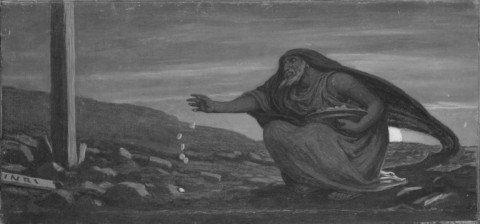200 years that shaped Judaism, Jesus, and all that followed
The religious world we know was formed between 250 and 50 B.C.E.

In Matthew’s Gospel, Jesus tells the parable of a man sowing good seed in a field. In the night, an enemy sows tares (weeds) among the wheat, and the two kinds of plants grow up together. The farmer tells his servants not to try purging the tares immediately, lest they damage the wheat. Jesus explains his meaning:
He that soweth the good seed is the Son of man; The field is the world; the good seed are the children of the kingdom; but the tares are the children of the wicked one; The enemy that sowed them is the devil; the harvest is the end of the world; and the reapers are the angels. . . . The Son of man shall send forth his angels, and they shall gather out of his kingdom all things that offend, and them which do iniquity; And shall cast them into a furnace of fire: there shall be wailing and gnashing of teeth. Then shall the righteous shine forth as the sun in the kingdom of their Father. (Matt. 13:37–43, KJV)
Read our latest issue or browse back issues.
The rigorous determinism of this passage—the implication that humans are born good or wicked, with no ability to change their destiny—together with its hellfire imagery, makes it unpopular among modern-day Christian preachers.
As with many such stories credited to him, Jesus used commonplace rural imagery. He framed it, though, in a worldview that made many assumptions about spiritual realities as well as the universe and its hierarchies. Forces of good and evil, light and darkness, contend in the world until God’s final victory. People must be urgently concerned about these conflicts because their conduct in the present world affects their fate in the afterlife.
Although this parable is unusually explicit in its imagery, the basic ideas are quite unsurprising to anyone who knows the West’s religious heritage. Angels and judgment, Messiah and Satan, hell and demons—these are the familiar building blocks of Western religion. They are also staples of two millennia of Christian art. All are integrated into a complex mythological system.
What few modern readers will understand from such a passage is just how new the themes were at the time Jesus preached. Clearly, we assume, the source for these ideas is the Bible. But however pervasive they are in the New Testament, they are not firmly rooted in the Old. During the period covered by the Hebrew Bible, up to around 400 BCE, few of these ideas existed in Jewish thought, and those that did were not prominent. By the start of the Common Era, these motifs were thoroughly integrated and acclimatized into the Jewish religious worldview. They have shaped Western faith and culture ever since.
So much of what we think of as the Judeo-Christian spiritual universe was conceived and described only after the closure of the canonical Old Testament text. Virtually every component of that system entered the Jewish world in the two or three centuries before the Common Era, and we can identify a critical moment of transformation around the year 250 BCE. These centuries constitute a startlingly little-known historical era that has seldom received the attention it deserves. It was in these years when the heavens and hells became so abundantly populated and when the universe was first conceived as a battleground between cosmic forces of Good and Evil. With the rise of Christianity, such Jewish-derived themes spilled forth into the wider world, becoming transcontinental. In the seventh century, Islam fully absorbed and incorporated these religious components as well. Today, these beliefs are the shared cultural inheritance of well over half the world’s people.
During the two tempestuous centuries from 250 through 50 BCE, the Jewish and Jewish-derived world was a fiery crucible of values, faiths, and ideas, from which emerged wholly new religious syntheses. Such a sweeping transformation of religious thought in such a relatively brief period makes this one of the most revolutionary times in human culture. These years in effect created Western consciousness. In terms of its impact on human culture, the crucible era is at least as significant as the celebrated Axial Age, which has been identified as being several centuries earlier and producing great intellectual leaps in societies as diverse as Greece, India, and China.
The emerging crucible era was not the creation of isolated thinkers or writers who designed their religious system according to literary whim. On the contrary, these new ideas developed in direct response to cultural crises and political events of that time.
The period began with Hellenistic kingdoms ruling the Middle East during the third century BCE and a Jewish encounter with globalizing modernity that produced both social tumult and effervescent creativity. These centuries were marked by the massive expansion of cities and of commercial economies, persistent conflict between native peoples and foreign rulers, and the growing importance of diaspora communities. Throughout this period, Jews were in intimate contact with powerful religious and intellectual influences, from Mesopotamian religions and Persian Zoroastrian beliefs to the multiple philosophical currents of Hellenism.
Such intoxicating ideas could not fail to leave their impact on Jewish thinkers, but these new directions were not merely a response to foreign influences and imports. Yes, the Zoroastrian faith taught ideas of a Last Judgment and of something like the devil and angels, while Jews and Christians borrowed from Greek terminology. But the picture is not as simple as scholars might once have believed. In the Zoroastrian case, we are much less confident than we might once have been about exactly when such religious themes emerged in the Persian setting and how they were transfused into the Jewish worldview. Similarly, with the Greeks, multiple schools of thought affected the Jewish world. But some—such as Platonism—were vastly more significant than others, such as Cynicism or materialist skepticism. It was not a question of whether external influences were available, but rather which of them appealed most to the needs and tastes of the potential recipients at a given time. The demand side of the equation mattered as much as supply.
And the demand was high. These foreign currents flooded into a Jewish world that was, quite independently, in the course of its own religious reconstruction, a natural and logical outgrowth of strict monotheism. The growth of pure monotheism during the seventh and sixth centuries BCE raised troubling questions about the means by which God could act in history. Monotheism created an intellectual need for intermediary figures who enacted the divine will in God’s stead, and that necessitated belief in the reality and power of angels.
Meanwhile, attempts to explain the existence of evil in a divinely ordained system inspired an obsessive interest in dark angels and in Satan himself. The need to see justice in the divine order inspired a vital new belief in concepts of the afterlife and resurrection, in ultimate rewards and punishments. Persian and Greek worldviews were welcomed into a Jewish system that was already in headlong transformation, accelerating changes already in process.
Jews were in frequent contact with other groups, and they had to decide how those strangers related to their own world and their own God. If there was one God, then he must in some sense be the God of the whole world. But universalism itself raised many questions. Was truth designed for only one racial group, or could others adopt it? Most daringly, might the spiritual universe expand to include other beings who could be understood as being godlike? Could Jewish rulers dare to appropriate Greek and foreign styles of authority, which raised kings to near-divine status (and sometimes not just “near”)? Such questions became acute when so many Jews lived outside Palestine, in a widespread diaspora. Judaism was founded on the principles of one God and of one holy people in a sacred land. How far could the people sing the Lord’s song in the strange countries of the diaspora?
Believers faced daily debates over exclusivism and universalism, and issues of ritual purity proved especially divisive. Some responded by stressing ethnic particularism, condemning the gentile world as the realm of darkness. Other thinkers followed the implication of doctrines of God’s transcendent authority to preach a bold universalism. That view was symbolized in these years by a new emphasis on Adam, the parent of all humanity, whether Jewish or gentile. At the same time, the ancient pre-Flood (and thus pre-Covenant) patriarchs became the subjects of extensive pseudoscriptural writings. So bitter did debates between various factions become that from the second century BCE onward, some thinkers whom we would undoubtedly call Jews were attacking others (who were no less certainly Jewish in our eyes) to the point of rejecting their religious identity altogether. Universalist approaches reached a new height in the early Christian world, when the apostle Paul extended to all believing gentiles membership in a new Israel, under a new covenant.
Scarcely less innovative than the new insights that emerged in this period were the means by which humanity learned such truths, namely, through the sacred texts and scriptures that presented divine revelations. Even if living teachers and charismatic prophets still mattered enormously in the crucible years, religious belief was chiefly conveyed through scriptures, some of which enjoyed special status. Obviously, texts had played a sanctified role in previous centuries, but much closer attention was now paid to specifying and controlling the limits of approved scripture. Creating the concept of the Bible had a profound impact on the character of religious authority and the people or institutions qualified to exercise it.
The new role of texts and scriptures also meant that religious debate and speculation would proceed through writings modeled on canonized Bible books. Although Christians call this period intertestamental—that is, lying between Old and New Testaments—it has left extensive records in the form of many texts presented in scriptural format but nevertheless excluded from the scriptural canons of either Jews or (most) Christians. It was not that writers after 250 BCE ceased producing spiritual treatises. Rather, at least some religious groups made the gradual (and arbitrary) decision to exclude these writings from the new category of scripture. Some of these texts are celebrated today because of their spectacular discovery among the Dead Sea Scrolls, but many others also exist. The sheer volume of such writings in the second century BCE alone is deeply impressive.
Political events and culture wars called forth literary responses, often framed in terms of visions credited to ancient prophets and sages. Enoch, Ezra, Baruch, and Isaiah were all reliable names to whom works could be credited. Contemporary writers also greatly expanded the already available biblical accounts of patriarchs like Adam, Seth, and Melchizedek. These texts are sometimes called pseudepigrapha, that is, falsely titled works, as opposed to being false in their nature or deficient in quality.
Such works were very influential. Any attempt to understand the range of ideas available to Jews of the first century CE, and to the circle of Jesus himself, means reading not just such Deuterocanonical works as Sirach and Tobit, but also pseudepigrapha like 1 Enoch, the Psalms of Solomon, and the Testaments of the Twelve Patriarchs. In terms of their subject matter, these works cover a huge spectrum. Some writings are political manifestos, others contain polemical material on the vices of a particular king or dynasty or high priest, while still others have no discernible relationship to current events. Taken together, they constitute a substantial written universe, demonstrating the enormous range of ideas in contemporary discourse.
Many of the motifs in these pseudepigraphic writings are familiar to us through the Abrahamic religions, while others now seem eccentric, even shocking, and do not fit in the established orthodoxies of any mainstream faith today. The fact that they seem so strange and exotic is significant for what it suggests about how and why some of those crucible-era themes triumphed, while others faded into obscurity.
Judaism as we know it historically is the complex of religious beliefs and practices that were formulated and proclaimed by rabbinic scholars in the early centuries of the Common Era and developed over a long period in the Talmud. Those scholars were working after the great revolt and the loss of the Temple in 70 CE. As such, they were profoundly suspicious of apocalyptic, messianic, or millenarian ideas of the kind associated with political militancy. In consequence, many once-popular texts and themes vanished from the Jewish heritage. A period of intense cultural rethinking fundamentally redefined the limits of acceptable religious faith, closing many of the intellectual avenues that had been so avidly explored during the crucible years.
Any history of the Jewish world in the crucible era itself must avoid hindsight in using such terms as mainstream and marginal, normative and sectarian, orthodox and heretical. Only retroactively were some sectarian movements and motifs consigned to the fringes of that broad cultural universe. That comment applies to many of the themes of the Dead Sea Scrolls. Early Christianity itself was an authentic heir of the speculations and obsessions of the crucible years. And through both rabbinic Judaism and Christianity, such ideas shaped the nascent faith of Islam. All three were heirs of the same religious revolution and shared very similar beliefs about the spiritual universe. So also, indeed, was the now extinct dualist faith of Manichaeism. Even some of the ideas from the crucible era that strike our modern eye as bizarre and extravagant proved remarkably durable.
The crucible era was incredibly fertile both in generating new spiritual concepts and in naming them. The rise of new spiritual and political worlds created an urgent need for new words, many of which remain at the core of the Western religious vocabulary. Even offering a brief list of such words in English gives a sense of how much we owe to this era, and some European languages include even more examples.
These centuries needed a term for the new and pervasive concept of apocalypse and also popularized the concept of Armageddon. Even when older Hebrew terms were translated more or less laterally into Greek, they could not fail to acquire many new trappings from Hellenistic thought and philosophy. Those additional meanings have been passed on to us today. Although the Jewish world had its notion of subdivine spiritual beings, it borrowed from Greek the terminology of angels and demons, with their elaborate hierarchies that included archangels. And although the concept of the Lord’s Anointed, the messiah, dated back at least to the sixth century BCE, its meaning was transformed into the later end times image of the moshiach, or Christos—the Christ. That in turn generated other names for new things, such as for Christians and for the Antichrist. Both Christ and Antichrist would play their roles at the final crisis, the Greek word co-opted to portray the final judgment. So would Satan, an old Hebrew word for adversary. The title in these years, however, applied to a specific and vastly threatening spiritual entity.
We observe in this era the invention of the Bible itself and the idea of scripture. It was the crucible age that specified that certain texts should be defined as the definitive holy scriptures of the Jewish people. Only in this same era do we find a specialized word for those writings that made up scripture or the scriptures (he graphe, singular, or tes graphes, plural). Several books of the Bible composed long before the crucible era bear Greek names that reflect their translation during these years, commonly the third and second centuries BCE. We think of works like Genesis, Exodus, and Deuteronomy. The list of approved texts was the canon, whereas other works were hidden, or apocryphal. Those Greek Bible translations gave us many religious terms, including blasphemy, diaspora, idol, paradise, holocaust, and proselyte. The Septuagint Greek word diabolos gave us devil.
Although the Hebrew Bible includes the word Yehudi, it is only in the crucible period, in the book of Esther (written during the third or second century BCE), that it comes to mean Jew in the historic ethnoreligious sense. A few decades later, the second book of Maccabees invented the word Judaism (with Hellenism thrown in for good measure to define its rival). Some words, like rabbi and synagogue, were invented to describe the new institutions of a developing faith. Some partisan or sectarian labels, such as zealots and Pharisees, also entered general usage.
In other cases, words in general parlance came to be applied to particular religious concepts and innovations. This happened within Judaism at first, but it was soon adopted by Christianity. Examples included apostle (messenger), baptism, disciple, and martyr (witness). Jewish sects had their episkopoi before Christians did, and long before English speakers corrupted that title into bishops. The Greek term for good news was evangelion, which in turn gave rise to evangelist and evangelical. Translating good news into Old English gave us the word gospel. Jewish sectarians called the Therapeutae had a monasterion, a room for contemplation, which developed into the later concept of the monastery. We can scarcely imagine a time when religion lacked such foundational terms.
The crucible years from the mid-third century BCE through the mid-first made the religious world the West has known ever since. Without this spiritual revolution, neither Christianity nor Islam would exist, and Judaism itself would have been unimaginably different.
A version of this article appears in the October 11 print edition under the title “The crucible era.” It was excerpted from Crucible of Faith: The Ancient Revolution that Made Our Modern Religious World, © 2017 by Philip Jenkins. Available from Basic Books, an imprint of Perseus Books, a division of PBG Publishing, LLC, a subsidiary of Hachette Book Group, Inc.






